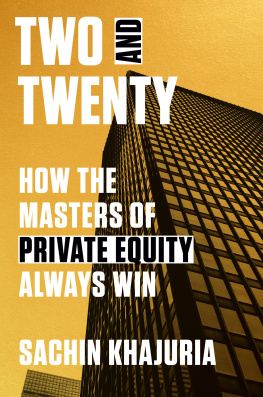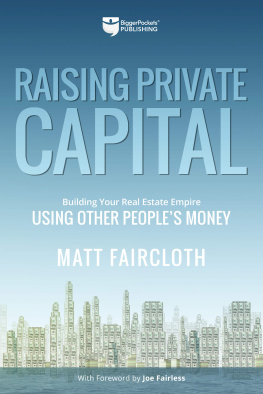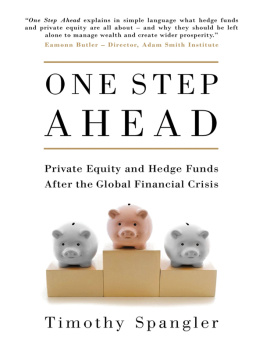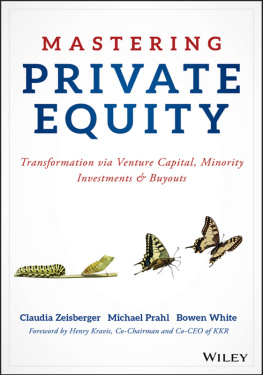Published in June 2013 by
PEI
140 London Wall
London EC2Y 5DN
United Kingdom
Telephone: +44 (0)20 7566 5444
www.peimedia.com
2013 PEI
ISBN 978-1-908783-20-2
eISBN 978-1-908783-47-9
This publication is not included in the CLA Licence so you must not copy any portion of it without the permission of the publisher.
All rights reserved. No parts of this publication may be reproduced, stored in a retrieval system or transmitted in any form or by any means including electronic, mechanical, photocopy, recording or otherwise, without written permission of the publisher.
Disclaimer: This publication contains general information only and the contributors are not, by means of this publication, rendering accounting, business, financial, investment, legal, tax, or other professional advice or services. This publication is not a substitute for such professional advice or services, nor should it be used as a basis for any decision or action that may affect your business. Before making any decision or taking any action that may affect your business, you should consult a qualified professional adviser. Neither the contributors, their firms, its affiliates, nor related entities shall be responsible for any loss sustained by any person who relies on this publication.
The views and opinions expressed in the book are solely those of the authors and need not reflect those of their employing institutions.
Although every reasonable effort has been made to ensure the accuracy of this publication, the publisher accepts no responsibility for any errors or omissions within this publication or for any expense or other loss alleged to have arisen in any way in connection with a readers use of this publication.
PEI editor: Wanching Leong
Production and design manager: Miriam Vysna
Printed in the UK by: Hobbs the Printers (www.hobbs.uk.com)
Contents
Introduction
Conclusion
Technical issues in raising capital in Chile
Restructuring process
Figures and tables
Figures
Tables
Table 13.3:Latin American pension fund investment growth in international securities
About the editor
Kevin K. Albert is a partner and the global head of business development at Pantheon, an industry-leading manager of private equity and infrastructure fund, secondary and co-investment programmes for over 300 institutional investors.
Prior to joining Pantheon, from 2005 until 2010, Kevin was a managing director and head of investor relations at Elevation Partners, a private equity firm that he helped launch. For 24 years prior to joining Elevation, he worked in the investment banking division of Merrill Lynch where for the majority of his career he was the global head of a market-leading private fund placement business.
Kevin serves on the board of Dover Saddlery, Inc., the largest multi-channel marketer of equestrian products in the United States, as an independent director and chair of the audit committee. He also serves as an independent director on the board of Merrill Lynch Ventures, LLC, a series of private equity partnerships offered to key Merrill Lynch employees aggregating over $1.8 billion of original committed capital.
Kevin received a BA and an MBA from the University of California, Los Angeles.
Foreword
By Jay Fewel, Oregon State Treasury Investment Division
The private equity asset class has come a long way in the past three decades. It has grown from a cottage industry to a large, mainstream investment strategy employed by most sophisticated investors the world over. From the standpoint of 2013, todays private equity industry both qualitatively and quantitatively is essentially unrecognisable from that which existed in the early 1980s, when Oregons public employee pension plan made its first investments in the space.
To illustrate, in 1981 a little firm by the name of Kohlberg Kravis Roberts approached the Oregon public employee pension seeking about $170 million to complete a buyout of the states home-grown grocery chain Fred Meyer, Inc. At the time, KKR had only done a relative handful of deals going back to the 1970s, and so its track record was limited and inconclusive. Further, in 1981, the leveraged buyout transaction model was not yet a proven strategy. But the pension plan was able to get comfortable with the capabilities of the team and the soundness of the transaction, and it did not hurt that the promised returns were quite attractive. So the investment was made and Oregon played its part in pioneering the early formation of the private equity asset class, a bet which has paid off well for the pension plan over the intervening decades. KKR has done pretty well too and its latest flagship fund garnered a $750 million commitment from Oregon.
For some perspective on the magnitude of this change, just look at the numbers. Back then, fewer than 500 firms raised about $100 billion in commitments over the entire decade, across all strategies. By 2012, roughly 4,300 firms have raised close to $4 trillion in commitments over the previous ten years. And it is not just the quantities that tell the story. In the industrys infancy, differentiated strategies were generally unheard of private equity was itself a niche strategy within the larger asset allocations of institutional investors. A fund size of $100 million raised eyebrows. Buyout funds dominated the asset class with venture capital taking second place, financial engineering was the value-add of the day, and most of the action was taking place in the US. Most institutional investment staffs were largely unfamiliar with the asset class, and there were few, if any, advisors that were competent to lend a hand in this area. Even the forms and standards relating to the limited partnership investment vehicle, which were borrowed from the tax shelter industry, were still in a state of development.
Today, investors can choose from a wide spectrum of specialised strategies, including distressed and turnaround managers, sector-focused buyout firms of all sizes, regional or country-specific funds, real estate, credit-oriented strategies, infrastructure investments, co-investment programmes and secondaries. Some fund managers still play the old leverage game, but it doesnt have the same bang for the buck that it did in the past. The focus now is on bringing real operating expertise to companies to improve bottom lines, help with strategic initiatives, fill out the senior management team, and make and integrate smart acquisitions. Further, the world is the private equity investors oyster while the US still has important advantages, investors can now use private equity to gain access to growth in regions like China, corporate divestitures in the EU, or small and mid-market companies in Latin America or Southeast Asia. The overwhelming majority of institutional investors of any size have formal private equity allocations and there now exists a host of advisory firms to provide expertise in navigating the large number of private equity investment opportunities today.
Through all of these changes, one thing has stayed the same: fundraising remains the lifeblood of the private equity industry. It is true for all investment management industries, yet it also remains a task that most investment managers would prefer to not have to undertake at all. But a dismissive attitude towards the modern requirements of fundraising bodes ill for most private equity managers. There have been times most recently in 2005-2006 and before that in the run-up to the internet bubble when a feeding frenzy mentality prevailed among limited partners seeking allocations to top-performing funds. During these periods, top-tier (and even second-tier) managers were more or less able to garner all the capital they required without much real effort. However, the relationship between institutional investors and private equity managers is in equilibrium for most periods, which means that effective fundraising can make a real difference between obtaining the commitments you seek and going home disappointed.










